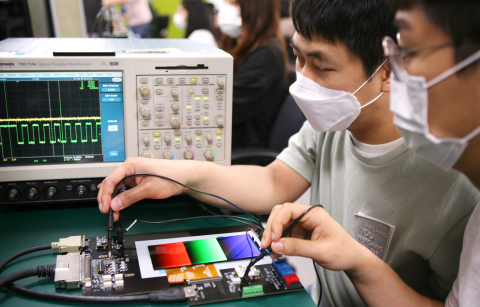SEOUL, South Korea--(BUSINESS WIRE)--Samsung Display Company today revealed new display technology that features a remarkable power-saving function for mobile electronics, being commercialized for the first time in Galaxy Note20 Ultra 5G flagship smartphones.
The display company has now successfully commercialized its low-power OLED adaptive frequency technology, which can curtail the operating power of a phone’s display by as much as 22 percent over existing smartphones now in general use.
“High-definition video streaming and gaming are expanding their capabilities in line with 5G commercialization, creating a widespread need for display panel technologies that can enable greater power savings,” said Ho-Jung Lee, Vice President of the mobile display product planning team for Samsung Display.
“Our Adaptive Frequency display technology is expected to considerably enhance the user experience by calibrating refresh rates in line with the requirements of a specific application and therein more precisely allocating available power. This will free up time for other smartphone operations,” Lee added.
The company’s power-saving technology allows the display panel to utilize variable refresh rates that consume the least possible amount of power for each type of application. The adaptive frequency technology supports a 120Hz scan rate for playing mobile games that require speedy frame changes, a 60Hz rate for movie streaming, a 30Hz rate for email correspondence, and a 10Hz rate for viewing still images or browsing social networking services.
Existing smartphone panels offer only a fixed refresh rate. They cannot automatically calibrate a phone’s refresh rate, which would result in image flickering caused by luminance differences at lower refresh rates. Samsung Display’s new backplane** technology eliminates flickering for operating frequencies as low as 10Hz.
In particular, when displaying still images, the new variable-rate panel has proven to consume operating power of as little as 60 percent by introducing a low-frequency refresh rate of 10Hz, while conventional panels unnecessarily waste power through the use of a consistent, fixed frequency regardless of the type of content.
The world-leading display company also anticipates employing this cutting-edge, power-saving technology with other advanced IT products in the future, to help boost material efficiency and optimize the functionality of operating components.
About Samsung Display
Samsung Display Co., Ltd. is a global leader in display panel market, with OLED and LCD technologies and products. Samsung Display has seven production facilities and five branch sales offices worldwide. The company specializes in high-quality displays for consumer, mobile, IT and industrial usage, including those featuring OLED (organic light emitting diode) and LCD technologies. As a total solution provider, Samsung Display strives to advance the future with next-generation technologies featuring ultra-thin, energy-efficient, flexible, and transparent displays. For more information, please visit www.samsungdisplay.com.
* Refresh (or Scan) Rate:
The number of frames that a display panel delivers in one second. For example, a 120Hz refresh rate accounts for 120 frame changes. Higher scan rates result in more lively and natural-appearing images.
** Backplane Technology
Making substrates such as glass and polyimide (PI) that are comprised of thin-film transistors (TFTs) required to operate pixels, the minimum unit comprising most display panels.




